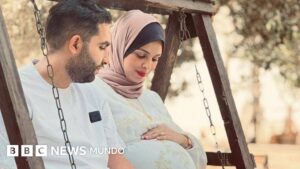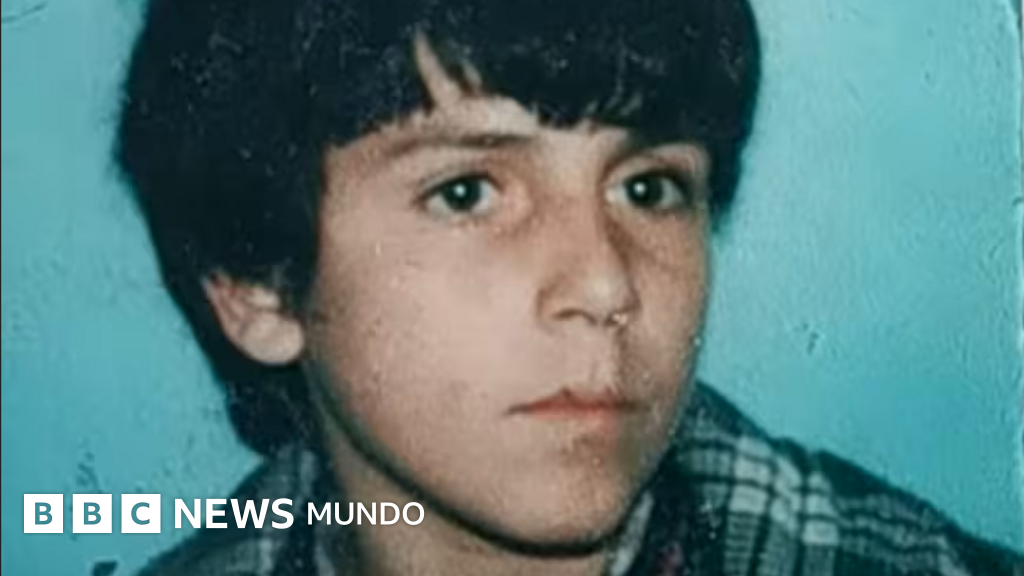
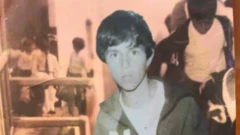
Image source, Fernández family
-
- Author, Darío Brooks
- Author's title, BBC News World
-
More than four decades after the disappearance of a teenager in Buenos Aires, the unknowns of the case have captured the attention of the Argentines.
Diego Fernández Lima, 16, disappeared on July 26, 1984.
As his brother Javier told BBC Mundo, that day the boy left his parents' house around 2:00 p.m. to go to school. His family never saw him again.
Despite the many efforts to locate it, there was no trace of Diego during the four decades after his disappearance. Until last May there was an unexpected finding.
Some workers who made an excavation in the garden of a house in the Coghlan neighborhood, in northern Buenos Aires, found bone fragments. Subsequent DNA tests confirmed that it was Diego's remains.
“I felt anger, helplessness, sadness and, at the same time, joy because I found my brother 41 years later. When they give me my body I can say goodbye in peace as he deserves,” said his brother Javier.
But the finding has also generated questions about the circumstances of the death of the teenager, about whom or who were involved and the reason for the alleged murder.
1. When and how Diego disappeared
As Javier Fernández told BBC Mundo, on July 26, 1984, his older brother warned his mother around 14:00 that he left home to visit a friend and then to the College, the National School of Technical Education (ENET).
At 8:30 pm he had not returned home, so his parents were given the task of locating him.
They asked neighbors, colleagues from the school and their football club, among others, but nobody knew anything. They asked for the help of the police, but they told them to stay calm, that he would surely have escaped with a girlfriend and that he would return. The authorities never took care of the case, according to Diego's family.
His father, Juan Benigno Fernández, spent several years following any clue about his son's whereabouts. In fact, he died hitting while he was in one of the searches, his son Javier told BBC Mundo. His mother, Irma Lima, today, 87, also turned to Diego's location for years.
“Until recently she kept looking out the window to see if Diego returned,” Javier said.
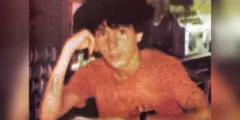
Image source, Fernández family
2. How Diego's remains were found
On May 20, some masons made an excavation on a field of Congress Street, in Coghlan, to lift a dividing wall. In the works, about 40 cm from the ground, they noticed that there was a hole and that bone remains stood out.
“We were working normally when the deceased appeared. We were excavating and the bone appeared. To know what it was, we began to dig a little to see if it was a bone of an animal or not,” said one of the masons to the newspaper to the newspaper The nation.
The de facto remains were in the backyard of the neighboring house that bordered the work.
Then it was learned that in that house in 1984 he lived with his family Cristian Graf, a companion of Diego from the Enet.
The masons gave notice to the police and, after the first analysis of the authorities, it was determined that they were human remains.
The case generated great media coverage in Argentina because it was initially reported that the bone remains had been found in a house in which the singer Gustavo Cerati had lived for a while, although later it was clarified that it was the adjoining housing.
A missing teenager's nephew saw the news and contacted the authorities, since he reminded him of his uncle's disappearance four decades ago.
The Local Prosecutor's Office, with support from experts from the Argentine Forensic Anthropology team (EAAF), found more remains and some personal objects: a corbatin, a clock, remains of clothing, a keychain and a coin, among others.
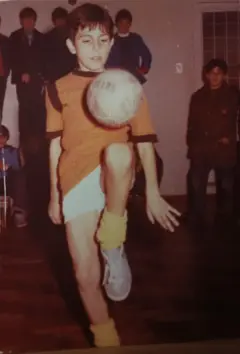
Image source, Fernández family
3. The Forensic Report
Forensic analysis first managed to determine that it was a young man between 16 and 19, of 1.72 m height and had suffered wounds caused with a puncture object in the back. There were also indications that he suffered blows to various parts of the body.
Mariella Fumagalli, the director of the EAAF, indicated that Diego probably suffered a stab on the back. The expert told the newspaper The nation that there were indications of “an attempt to manipulate the body”, possibly to dismember it.
Although the director of the EAAF said that it could be a homicide, it is the prosecution to which it corresponds to declare it thus after concluding the investigation that is ongoing.
What could later be corroborated with DNA tests is that the remains were Diego Fernández. Also that the objects found correspond to the time when the adolescent disappeared.
In total, they found 151 bone fragments.
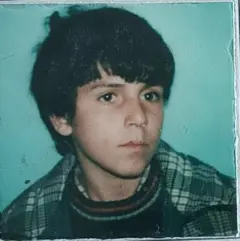
Image source, Fernández family
4. The unknowns of the case
The authorities are trying to determine what happened after the teenager left his home and how his remains arrived at the place where they were found.
Because the disappearance occurred four decades ago, if it were a murder, the crime would have prescribed under Argentine law.
However, the authorities are investigating the case to determine who or who would be involved in Diego's death and in the burial of his body.
Prosecutor Martín López Perrando is in charge of the investigation.
So far there is no defendant, but Cristian Graf, 58, has been summoned to declare having found the body in the perimeter of his family's property in Coghlan.
According to local press reports, Graf and Fernández were not close friends, but both were fond of motorcycles. The missing teenager had a and Graf knew of repairs.
Graf's lawyer, Martín Díaz, said that this “has nothing to hide” and that “has no imputation.” He has been collaborating with the requirements of the authorities, according to his defense.
However, prosecutor López announced that he asked a judge to be investigated for the crimes of “aggravated cover -up” and “suppression of evidence.”
They have also been called to declare six other people: the masons who made the discovery and ex -partners of the school. No details of their testimonies have been announced.
For the family, the finding of Diego's remains and research has been difficult moments. “This has been an agony,” said Javier Fernández.
With reporting by Cecilia Barría, from BBC News Mundo

Subscribe here To our new newsletter to receive every Friday a selection of our best content of the week.
And remember that you can receive notifications in our app. Download the latest version and act.
